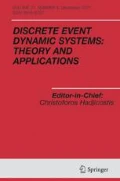Abstract
In this paper we use the event synchronization scheme to develop a new method for parallel simulation of many discrete event dynamic systems simultaneously. Though a few parallel simulation methods have been developed during the last several years, such as the well-known Standard Clock method, most of them are largely limited to Markovian systems. The main advantage of our method is its applicability to non-Markovian systems. For Markovian systems a comparison study on efficiency between our method and the Standard Clock method is done on Connection Machine CM-5. CM-5 is a parallel machine with both SIMD (Single Instruction, Multiple Data) and MIMD (Multiple Instruction Multiple Data) architectures. The simulation results show that if event rates of Markovian systems do not differ by much then both methods are compatible but the Standard Clock method performs better in most cases. For Markovian systems with very different event rates, our method often yields better results. Most importantly, our simulation results also show that our method works as efficiently for non-Markovian systems as for Markovian systems.
Similar content being viewed by others
References
Bratley, P., Fox, B., and Schrage, L. 1983.A Guide to Simulation. Berlin: Springer-Verlag.
Chen, C. H., and Ho, Y. C. 1995 Extension of the standard clock method for discrete event simulation.IEEE Trans. on Control Systems Technology, to appear.
Cassandras, C. G., and Strickland, S. 1989. Observable augmented systems for sensitivity analysis of Markov and Semi-Markov processes.IEEE Trans. on Automatic Control 34: 1026–1037.
Cassandras, C. G., and Strickland, S. 1989. Sample path properties of timed discrete event systems.Proceedings of the IEEE 77: 59–71.
Thinking Machines Corporation. 1994.CM-5 CM Fortran Performance Guide. Version 2.1.
Deng, M., Ho, Y. C., and Hu, J. Q. 1992. Effect of correlated, estimation errors in ordinal optimization.Proceedings of Winter Simulation Conference pp. 231–240.
Fujimoto, R. M. 1990. Parallel discrete event simulation.Commun. ACM 33(10): 30–53.
Glasserman, P., and Vakili, P. 1994. Comparing Markov chains simulated in parallel.Probability in the Engineering and Informational Sciences 8: 309–326.
Ho, Y. C 1994. A new paradigm for stochastic optimization and parallel simulation.Discrete Event Systems, Manufacturing Systems, and Communication Networks, P. R. Kumar and P. P. Varaiya (Eds.), Vol. 73 of Institute for Mathematics and Its Applications (IMA) Volumes in Mathematics and Its Applications. Springer-Verlag.
Ho, Y. C., Cassandras, C. G., and Makhlouf, M. R. 1993. Parallel simulation of real time systems via the standard clock approach.Mathematics and Computers in Simulation 35: 33–41.
Ho, Y. C., and Li, S. 1988. Extensions of infinitesimal perturbation analysis.IEEE Trans. on Automatic Control 33: 427–438.
Ho, Y. C., Li, S., and Vakili, P. 1988. On the efficient generation of discrete event sample paths under different system parameters.Mathematics and Computers in Simulation 30: 347–370.
Ho, Y. C., Sreenivas, R., and Vakili, P. 1992. Ordinal optimization of discrete event dynamic systems.DEDSTA 2: 61–88.
Marshall, A. W., and Olkin, I. 1979.Inequalities: Theory of Majorization and Its Applications. Academic Press.
Righter, R., and Walrand, J. C. 1989. Distributed simulation of discrete event systems.Proceedings of the IEEE 77(1): 99–113.
Ross, S. M. 1983.Stochastic Processes. Wiley.
Strickland, S. G., and Phelan, R. G. 1995. Massively parallel SIMD simulation of Markovian DEDS: Event vs. time synchronous methods, in this issue.
Vakili, P. 1991. Using a standard clock technique for efficient simulation.Operations Research Letters 10: 445–452.
Vakili, P. 1992. Massively parallel and distributed simulation of a class of discrete event systems: A different perspective.ACM Transactions on Modeling and Computer Simulation 2(3): 214–238.
Whitt, W. 1980. Continuity of generalized semi-Markov processes.Mathematics of Operations Research 5(4): 494–501.
Author information
Authors and Affiliations
Rights and permissions
About this article
Cite this article
Hu, JQ. Parallel simulation of DEDS via event synchronization. Discrete Event Dyn Syst 5, 167–186 (1995). https://doi.org/10.1007/BF01439039
Received:
Revised:
Issue Date:
DOI: https://doi.org/10.1007/BF01439039




